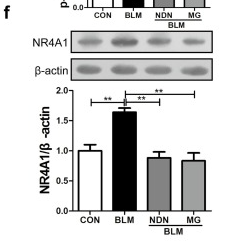NUR77 Antibody - #DF7850
| Product: | NUR77 Antibody |
| Catalog: | DF7850 |
| Description: | Rabbit polyclonal antibody to NUR77 |
| Application: | WB IHC IF/ICC |
| Cited expt.: | WB |
| Reactivity: | Human, Mouse, Rat |
| Prediction: | Pig, Bovine, Horse, Sheep, Rabbit, Dog |
| Mol.Wt.: | 64 kDa; 64kD(Calculated). |
| Uniprot: | P22736 |
| RRID: | AB_2841286 |
Related Downloads
Protocols
Product Info
*The optimal dilutions should be determined by the end user. For optimal experimental results, antibody reuse is not recommended.
*Tips:
WB: For western blot detection of denatured protein samples. IHC: For immunohistochemical detection of paraffin sections (IHC-p) or frozen sections (IHC-f) of tissue samples. IF/ICC: For immunofluorescence detection of cell samples. ELISA(peptide): For ELISA detection of antigenic peptide.
Cite Format: Affinity Biosciences Cat# DF7850, RRID:AB_2841286.
Fold/Unfold
Early response protein NAK1; GFRP 1; GFRP; GFRP1; Growth factor inducible nuclear protein N10; Growth Factor Inducible Nuclear Protein NP10; Growth Factor Response Protein 1; Hbr1; HMR; Hormone Receptor; MGC9485; N10; N10 nuclear protein; NAK 1; NAK1; Nerve growth factor IB nuclear receptor variant 1; NGFIB; NP 10; NP10; NR4A1; NR4A1_HUMAN; Nuclear hormone receptor NUR/77; Nuclear Hormone Receptor TR3; Nuclear receptor subfamily 4 group A member 1; NUR77; NUR77, mouse, homolog of; Orphan nuclear receptor HMR; Orphan nuclear receptor NR4A1; Orphan nuclear receptor TR3; Orphan receptor tr3; Receptor NGFIB; ST 59; ST-59; ST59; Steroid receptor TR3; Testicular receptor 3; TR 3; TR3; TR3 orphan receptor;
Immunogens
A synthesized peptide derived from human NUR77, corresponding to a region within the internal amino acids.
- P22736 NR4A1_HUMAN:
- Protein BLAST With
- NCBI/
- ExPASy/
- Uniprot
MPCIQAQYGTPAPSPGPRDHLASDPLTPEFIKPTMDLASPEAAPAAPTALPSFSTFMDGYTGEFDTFLYQLPGTVQPCSSASSSASSTSSSSATSPASASFKFEDFQVYGCYPGPLSGPVDEALSSSGSDYYGSPCSAPSPSTPSFQPPQLSPWDGSFGHFSPSQTYEGLRAWTEQLPKASGPPQPPAFFSFSPPTGPSPSLAQSPLKLFPSQATHQLGEGESYSMPTAFPGLAPTSPHLEGSGILDTPVTSTKARSGAPGGSEGRCAVCGDNASCQHYGVRTCEGCKGFFKRTVQKNAKYICLANKDCPVDKRRRNRCQFCRFQKCLAVGMVKEVVRTDSLKGRRGRLPSKPKQPPDASPANLLTSLVRAHLDSGPSTAKLDYSKFQELVLPHFGKEDAGDVQQFYDLLSGSLEVIRKWAEKIPGFAELSPADQDLLLESAFLELFILRLAYRSKPGEGKLIFCSGLVLHRLQCARGFGDWIDSILAFSRSLHSLLVDVPAFACLSALVLITDRHGLQEPRRVEELQNRIASCLKEHVAAVAGEPQPASCLSRLLGKLPELRTLCTQGLQRIFYLKLEDLVPPPPIIDKIFMDTLPF
Predictions
Score>80(red) has high confidence and is suggested to be used for WB detection. *The prediction model is mainly based on the alignment of immunogen sequences, the results are for reference only, not as the basis of quality assurance.
High(score>80) Medium(80>score>50) Low(score<50) No confidence
Research Backgrounds
Orphan nuclear receptor. May act concomitantly with NURR1 in regulating the expression of delayed-early genes during liver regeneration. Binds the NGFI-B response element (NBRE) 5'-AAAAGGTCA-3' (By similarity). May inhibit NF-kappa-B transactivation of IL2. Participates in energy homeostasis by sequestrating the kinase STK11 in the nucleus, thereby attenuating cytoplasmic AMPK activation. Plays a role in the vascular response to injury (By similarity).
Phosphorylated at Ser-351 by RPS6KA1 and RPS6KA3 in response to mitogenic or stress stimuli.
Acetylated by p300/CBP, acetylation increases stability. Deacetylated by HDAC1.
Nucleus. Cytoplasm. Mitochondrion.
Note: Nuclear export to the cytoplasm is XPO1-mediated and positively regulated by IFI27 (PubMed:22427340). Translocation to the mitochondrion upon interaction with RXRA and upon the presence of 9-cis retinoic acid (PubMed:17761950).
Fetal muscle and adult liver, brain and thyroid.
Belongs to the nuclear hormone receptor family. NR4 subfamily.
Research Fields
· Environmental Information Processing > Signal transduction > MAPK signaling pathway. (View pathway)
· Environmental Information Processing > Signal transduction > PI3K-Akt signaling pathway. (View pathway)
· Organismal Systems > Endocrine system > Aldosterone synthesis and secretion.
References
Application: WB Species: Mouse Sample: lung tissues
Restrictive clause
Affinity Biosciences tests all products strictly. Citations are provided as a resource for additional applications that have not been validated by Affinity Biosciences. Please choose the appropriate format for each application and consult Materials and Methods sections for additional details about the use of any product in these publications.
For Research Use Only.
Not for use in diagnostic or therapeutic procedures. Not for resale. Not for distribution without written consent. Affinity Biosciences will not be held responsible for patent infringement or other violations that may occur with the use of our products. Affinity Biosciences, Affinity Biosciences Logo and all other trademarks are the property of Affinity Biosciences LTD.






